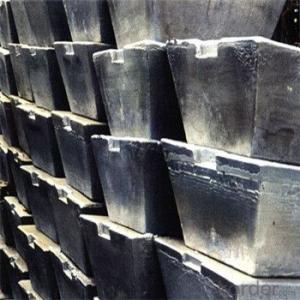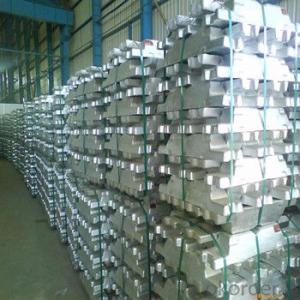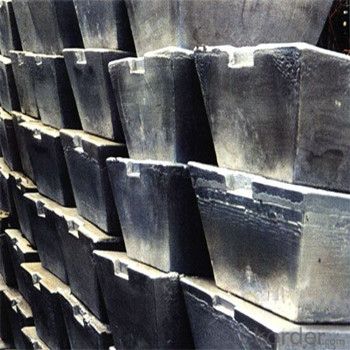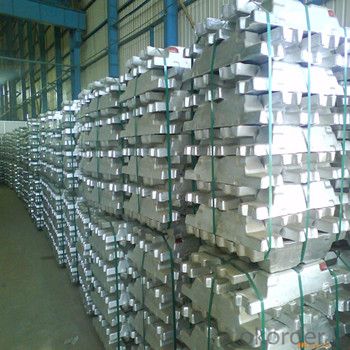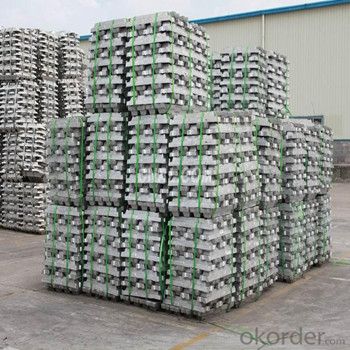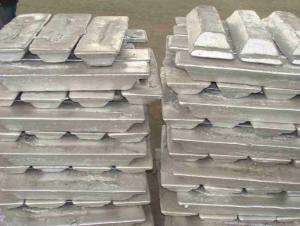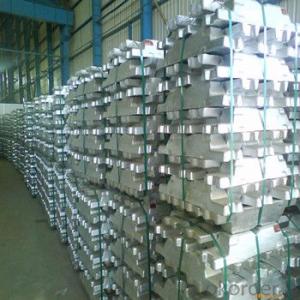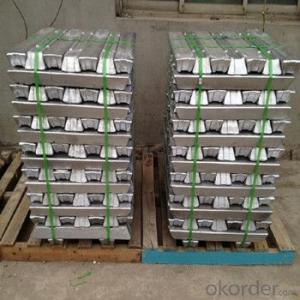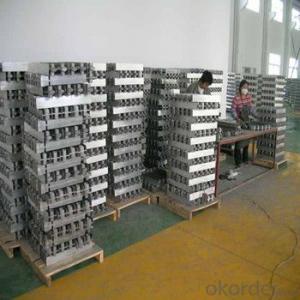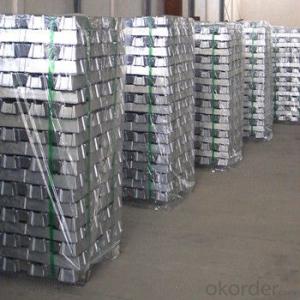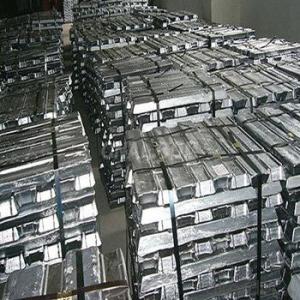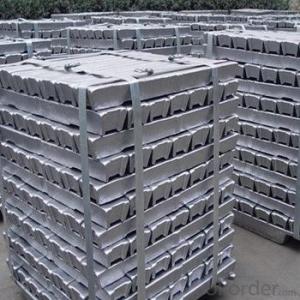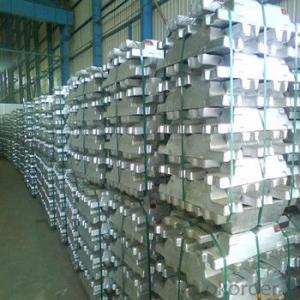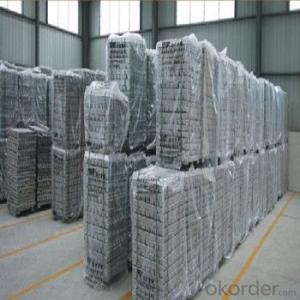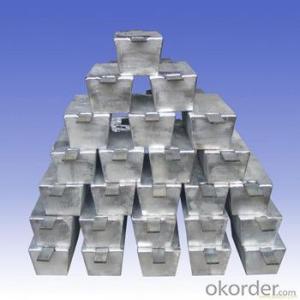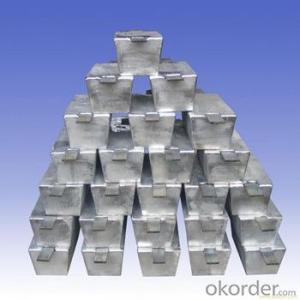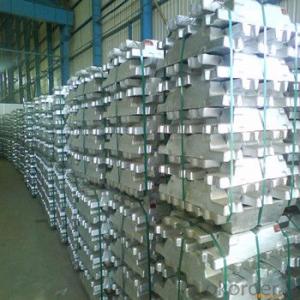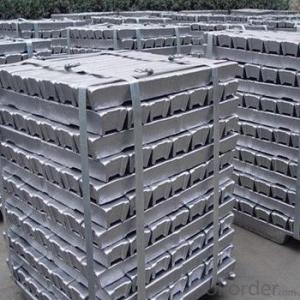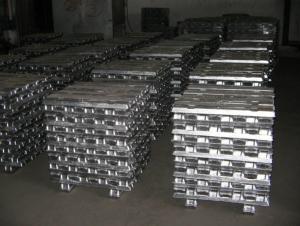Aluminum Ingot with Good Price and Good Quality
- Loading Port:
- China main port
- Payment Terms:
- TT OR LC
- Min Order Qty:
- 1000 m.t.
- Supply Capability:
- 10000 m.t./month
OKorder Service Pledge
OKorder Financial Service
You Might Also Like
Pure Aluminum Ingot Used for Industry
1.Structure of Aluminum Ingot Description
Aluminum Ingot is with the AL as the main chemical composition. Aluminum Ingot is used for industry,such as automobile,pinning and weaving,electron broadly and so on. Aluminum Ingot has the following advantages: easy control and operation, fast melting.
2.Main Features of the Aluminum Ingot
•High Purity
•Easy control and operation
•High strength
•Fast melting
•Competitive price
•Best Service
3. Aluminum Ingot Images
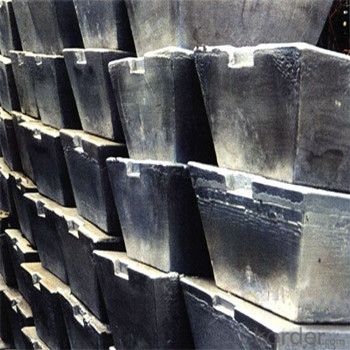
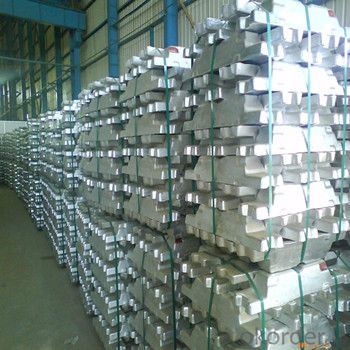
4. Aluminum Ingot Specification
Grade | Chemical Composition % | |||||||||
Al≥ | impurities ≤ | |||||||||
Si | Fe | Cu | Ga | Mg | Zn | Mn | others | Sum | ||
Al99.9 | 99.90 | 0.50 | 0.07 | 0.005 | 0.02 | 0.01 | 0.025 | - | 0.010 | 0.10 |
Al99.85 | 99.85 | 0.80 | 0.12 | 0.005 | 0.03 | 0.02 | 0.030 | - | 0.015 | 0.15 |
Al99.7 | 99.70 | 0.10 | 0.20 | 0.010 | 0.03 | 0.02 | 0.030 | - | 0.030 | 0.30 |
Al99.6 | 99.60 | 0.16 | 0.25 | 0.010 | 0.03 | 0.03 | 0.030 | - | 0.030 | 0.40 |
Al99.5 | 99.50 | 0.22 | 0.30 | 0.020 | 0.03 | 0.05 | 0.050 | - | 0.030 | 0.50 |
Al99.00 | 99.00 | 0.42 | 0.50 | 0.020 | 0.03 | 0.05 | 0.050 | - | 0.050 | 1.00 |
5.FAQ of Aluminum Ingot
We have organized several common questions for our clients,may help you sincerely:
①How about your company?
A world class manufacturer & supplier of castings forging in carbon steel and alloy steel,is one of the large-scale professional investment casting production bases in China,consisting of both casting foundry forging and machining factory. Annually more than 8000 tons Precision casting and forging parts are exported to markets in Europe,America and Japan. OEM casting and forging service available according to customer’s requirements.
②How to guarantee the quality of the products?
We have established the international advanced quality management system,every link from raw material to final product we have strict quality test;We resolutely put an end to unqualified products flowing into the market. At the same time, we will provide necessary follow-up service assurance.
③How long can we receive the product after purchase?
In the purchase of product within three working days, We will arrange the factory delivery as soon as possible. The pecific time of receiving is related to the state and position of customers.Commonly 7 to 10 working days can be served.
- Q: Now refining aluminum ingot profits? What are the main factories?
- As far as I know, without such special equipment, the national general practice is to use small furnace crucible to produce, products produced in the industry is commonly known as "coke ingot.".
- Q: Lead and Feng Sheng aluminum profile which is better
- Al Feng can't be compared with Zhensheng aluminum, aluminum frame is false, but a little thick, thin inner frame is good, it is to deceive the people and consumers, but not resistant and durable, the outer protective layer can be seen without vibration or aluminum smooth and bright, if there is a recommendation of Al - Feng, hope that consumers do not believe
- Q: How are impurities removed from aluminum ingots?
- Impurities are removed from aluminum ingots through a process called refining or purification. There are several methods used to achieve this, including: 1. Fluxing: Fluxes, such as chlorine or sodium chloride, are added to the molten aluminum to react with the impurities. This process forms compounds that are more easily removed as slag or dross. 2. Electrolytic refining: In this method, the impure aluminum ingots are immersed in an electrolyte solution and subjected to an electric current. The impurities are attracted to the anode, where they accumulate as a residue, while the purified aluminum collects at the cathode. 3. Centrifugal separation: This technique involves spinning the molten aluminum in a centrifuge, which causes the denser impurities to migrate towards the outer edge. The purified aluminum is then collected from the center. 4. Filtration: Filtration can be used to remove solid impurities from the molten aluminum. Filters made of materials like ceramic or graphite are employed, which trap the impurities while allowing the purified aluminum to pass through. 5. Vacuum treatment: In this method, the molten aluminum is subjected to a vacuum environment, which helps to remove volatile impurities like hydrogen and some low-boiling-point metals. The reduced pressure facilitates the removal of these impurities by vaporization. It is important to note that the specific method chosen for impurity removal depends on factors such as the type and concentration of impurities, the desired level of purity, and the cost-effectiveness of the chosen process. Different industries and applications may require different levels of purity, and thus, the refining process may vary accordingly.
- Q: What are the advantages of using aluminum ingots in the production of renewable energy systems?
- There are several advantages of using aluminum ingots in the production of renewable energy systems. Firstly, aluminum is a lightweight material, making it easier to transport and install in various renewable energy systems such as solar panels and wind turbines. This lightweight characteristic also reduces the load on supporting structures, leading to cost savings in terms of materials and installation. Secondly, aluminum has excellent corrosion resistance properties, which is crucial for renewable energy systems that are often exposed to harsh environmental conditions. This resistance ensures the longevity and durability of the systems, reducing maintenance and replacement costs. Additionally, aluminum is highly recyclable, with the ability to be reused repeatedly without any loss in quality. This recyclability aspect makes aluminum a sustainable choice for renewable energy systems, aligning with the goal of minimizing environmental impact. Furthermore, aluminum has high thermal conductivity, allowing for efficient heat dissipation in renewable energy systems. This property is particularly beneficial in applications like solar panels, where excess heat can reduce efficiency. By effectively dissipating heat, aluminum ensures optimal performance and extends the lifespan of the system. Moreover, aluminum ingots can be easily molded and customized into various shapes and sizes, enabling manufacturers to design renewable energy systems with enhanced efficiency. This flexibility in design helps optimize the system's performance and adapt to different project requirements. Lastly, aluminum is a cost-effective material compared to alternatives like steel or copper. The relatively low cost of aluminum ingots allows for more affordable production of renewable energy systems, making them more accessible to a wider range of consumers. In conclusion, the advantages of using aluminum ingots in the production of renewable energy systems lie in their lightweight nature, corrosion resistance, recyclability, thermal conductivity, design flexibility, and cost-effectiveness. These qualities contribute to the overall efficiency, durability, and affordability of renewable energy systems, making aluminum a preferred material in the industry.
- Q: What are cooked aluminium ingots and aluminium ingots? What specifications do they have?
- Aluminum impurities, hard and brittle nature, touch on the broken, so students cannot use the hammer on aluminum from a variety of activities, can only use sand to cast aluminum utensils, like wash basin, is cast with aluminum liquid.
- Q: How much is the power consumption to smelt a ton of aluminium ingot?
- Theoretically, 1 tons of aluminium ingots are melted down, consuming 500 degrees
- Q: Aluminum sold alone, high benefit ah, why do aluminum ingot?
- No, aluminium powder is made of aluminium ingots
- Q: What kinds of aluminum alloy material are used in casting?
- Aluminum profiles are widely used in furniture: screens, skeletons, various kinds of suspension beams, tables, feet, decorative strips, handles, winding grooves and covers, chairs, tubes and so on. They can be designed and used in a variety of ways!
- Q: What are the global production trends for aluminum ingots?
- Over the years, there has been a steady increase in global aluminum ingot production, driven by the high demand for this versatile metal in various industries such as aerospace, automotive, construction, and packaging. China, particularly the Asia-Pacific region, has emerged as the dominant player in aluminum ingot production. China's rapid industrialization and infrastructure development have played a significant role in its rise to the top. The country's ample reserves of bauxite and low production costs have attracted many global manufacturers to establish their operations there. North America and Europe also play a crucial role in aluminum ingot production, boasting well-established manufacturing bases and being home to several major aluminum producers. However, they face tough competition from China, which benefits from lower production costs. Moreover, the aluminum industry has been increasingly focused on sustainability and environmental consciousness. This has resulted in the adoption of energy-efficient technologies and the utilization of recycled aluminum scrap in the production process. Recycling aluminum not only reduces energy consumption but also decreases greenhouse gas emissions, making it a more sustainable option. Consequently, the global production of recycled aluminum ingots has been steadily rising and contributing to the overall production trends. In summary, the global production of aluminum ingots has been consistently increasing, with China leading the way as the largest producer. Despite their significant contributions, North America and Europe face fierce competition from China. Additionally, the industry is placing a greater emphasis on sustainability through recycling practices.
- Q: How are aluminum ingots used in the automotive industry?
- The automotive industry relies heavily on aluminum ingots, which are widely utilized in the manufacturing of various vehicle components. Engine blocks, for instance, are primarily produced using aluminum ingots due to their lightweight nature. This characteristic reduces the overall weight of the vehicle, thereby enhancing fuel efficiency and performance. Moreover, aluminum ingots are crucial for the production of wheels, transmission cases, cylinder heads, and other essential car parts. The high strength-to-weight ratio of aluminum makes it the preferred choice for these components, ensuring durability and enhancing overall safety. Furthermore, aluminum ingots are utilized in the construction of car body panels, including hoods, doors, and trunk lids. These aluminum panels significantly reduce weight compared to traditional steel panels, resulting in improved energy efficiency and handling. Additionally, aluminum's excellent corrosion resistance properties extend the longevity of these body panels. In recent years, the demand for electric vehicles (EVs) has grown, further highlighting the significance of aluminum ingots in the automotive industry. EVs require lightweight materials to offset the weight of battery packs, and aluminum ingots provide an ideal solution. The use of aluminum in EVs not only increases driving range but also enhances battery life and overall performance. To sum up, the automotive industry relies heavily on aluminum ingots for their lightweight nature, strength, and corrosion resistance properties. These ingots are vital components in engine blocks, transmission cases, wheels, body panels, and other critical parts, contributing to improved fuel efficiency, safety, and performance of vehicles.
Send your message to us
Aluminum Ingot with Good Price and Good Quality
- Loading Port:
- China main port
- Payment Terms:
- TT OR LC
- Min Order Qty:
- 1000 m.t.
- Supply Capability:
- 10000 m.t./month
OKorder Service Pledge
OKorder Financial Service
Similar products
Hot products
Hot Searches
